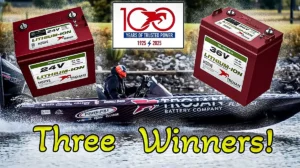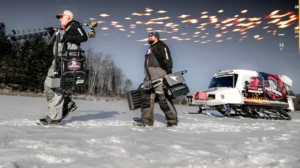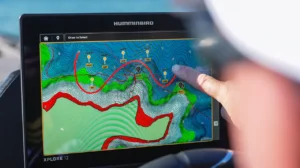Pro bass angler Justin Lucas jump-starts fall bass fishing strategies on reservoirs with riprap-lined bridge areas. As Lucas explains, bass on falling water temps concentrate around current-influenced bridge areas thanks to a concentration of baitfish. Additionally, rocks and bridge pilings provide abundant cover for bass and crawfish as a secondary feeding option to shad. Flat-sided crankbaits are one of the first baits Lucas grabs, as they allow him to cover a ton of water, closely mimic shad, and trigger reaction strikes from non-feeding bass.
TACKLE USED
- CRANKBAIT – Berkley Frittside Crankbait (size 5), color – Ghost Morning Dawn
- ROD – Abu Garcia Veritas Casting Rod, 7′ Medium
- REEL – Abu Garcia REVO MGX Casting Reel, 6.4:1
- LINE – Berkley Trilene 100% Fluorocarbon, 10- or 12-pound (depending on cover and desired running depth)
- SUNGLASSES – Costa Del Mar Corbina
Here’s are Lucas’ 4 tips for catching fall bass on crankbaits around bridges.
- Target bass around bridge neckdown areas with riprap, current, and a range of depths. Baitfish like shad, bluegill, and crappies pile in around bridge neckdowns, and they’re also prime bass real estate for this reason. As bass metabolism drops, they’re less willing to chase down prey; they don’t need to travel far for a meal around riprap-lined bridge areas. They also have excellent cover and quick access to deeper water.
- Use a flat-side crankbait. Fall drawdown and reduced precipitation often lead to cleaner water. Improved visibility combined with heavy fishing pressure favors the use of more subtle, tight wiggling crankbaits. In addition to looking like shad, realistic flat-side cranks allow you to fish fast and trigger reaction strikes when deflected off of the cover.
- Experiment with natural shad and red crawfish colors. Lucas always has a natural shad pattern tied on but advises mixing in some red hues when water temperatures drop into the low 50s to high 40s, when the bass diet comprises crawfish.
- Change casting angles. Lucas doesn’t leave a productive area until he peppers it with his crankbait from many angles. Like contacting cover and making speed changes, changing casting angles presents the bait to bass differently based on their positioning. There’s often a “magic” angle, you just gotta find it.












